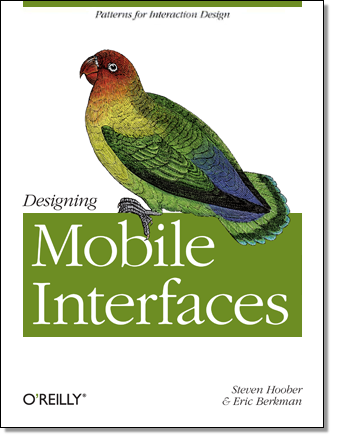|
Size: 7381
Comment:
|
Size: 7372
Comment:
|
| Deletions are marked like this. | Additions are marked like this. |
| Line 35: | Line 35: |
| ----- |
Designing Mobile Interfaces: Patterns for Interaction Design
 Designing Mobile Interfaces: Patterns for Interaction Design is the comprehensive, platform-agnostic reference for your mobile design work. Whether you design or develop for smartphones, featurephones, tablets, or other touchscreen devices, common principles are discussed and codified as 76 universal interaction and interface patterns. Designing Mobile Interfaces has been translated into multiple languages, used to teach interactive design at universities, and guided the creation of countless apps, websites and even entire OSs like Firefox.
Designing Mobile Interfaces: Patterns for Interaction Design is the comprehensive, platform-agnostic reference for your mobile design work. Whether you design or develop for smartphones, featurephones, tablets, or other touchscreen devices, common principles are discussed and codified as 76 universal interaction and interface patterns. Designing Mobile Interfaces has been translated into multiple languages, used to teach interactive design at universities, and guided the creation of countless apps, websites and even entire OSs like Firefox.
Each pattern explains the underlying psychology and physiology, describes best practices in implementation, and lists pitfalls and "best practices" you should watch out for and avoid. Every pattern is grouped with similar or optional patterns, and appendices detail key background information from typography to the principles of mobile networks. You get not just a list of designs and out of date screenshots, but have a base of knowledge to make up your own mind, and react to the always-changing mobile environment.
"Designing Mobile Interfaces is another stellar addition to O’Reilly’s essential interface books. Every mobile designer will want to have this thorough book on their shelf for reference." — Dan Saffer
Buy it from Amazon:
Buy it direct from O'Reilly:
Read in other languages
Designing Mobile Interfaces has been translated into Russian, Chinese, Korean, and Italian. Other languages and editions
Read it Online
Or, you can just read the whole book right here on this wiki. Pretty much every bit of content from the book is posted online.
It is also regularly updated, especially the reference sections, so even if you buy the book check back for updates, and contact us with errors, suggestions or to get access to the wiki to add updates yourself.
Designing for Fingers, Touch & People
If there's anything I'm the expert on now, it's how people hold and touch their mobile phones and tablets. I'm trending towards fully writing a smallish book on it. This is where I am working on it or just check out the Touch overview page for the most current complete articles, presentations, videos, guidelines and references.
Designing Smartphone Interfaces
I had planned on updating the patterns to create an eventual second edition, and I certainly have added plenty of notes and so on, but now think I may propose a fairly different type of follow-on book. This is where I am working on it.
Not Desktop, But Not Quite Mobile
Though the patterns are supposed to be general enough to apply to kiosks, telematics, 10-foot Ui, etc. experts in those fields insist they just aren't. I have given in and in the interest of increasing knowledge, am going to start linking to the good stuff in related domains.
Kiosks even if they are made by strapping an iPad to the wall, have different context, and different environmentally-derived interactions. Design them differently.
Designing Software for Kiosks by Studio IQ. Good tips. Keep bugging them, and maybe we'll get a full repository of info out of them.
Designing Intuitive Point-of-Interest and Point-of-Sale Touch Interfaces
10-foot-UI is any interactive experience viewed from a distance. The usual assumption is a TV in a living room. Smart TVs have brought this out of the game console, and made it more mainstream. Your website is getting viewed at 10 foot range, in group settings.
Global Experience Language - TV by the BBC - Style guides and many guidelines and principles for TV graphics and interactive TV.
TV Screen Sizes by popularity of Web viewing, September 2013
Telematics
Dark Screens in Cars a discussion that took off with many good links.
Car UX is just a bunch of photos of car control panels. So, continuing the bad tradition of confusing UI with UX.
Games No matter what they are on, game design is a bit different. Different enough I did not cover it in anything else in this book. Game design resources (TBD) should be referenced generally.
That Game's UX terrific blog on gaming, with all sorts of great UX principles applied or reviewed.
Designing Better Controls for the Touchscreen Experience from Gamasutra.
Augmented Reality - Not really a platform like the others, I have seen enough good stuff that is really pushing the bounds of what we think of as interaction and interface that I think AR also needs a separate and robust set of standards. Now.
Augmented Reality Standards and Examples that I have gathered
Speaking Engagments, Presentations, Webcasts...
Eric works in Sydney, Australia. Steven lives in the Kansas City, Missouri (US) area.
We're pretty busy with day jobs, freelance jobs and so on. But if we're scheduled to go somewhere and talk about anything remotely related to mobile (and it's an open meeting you can come to) we'll post it here.
Mentions, Reviews & Other Writing
We (and especially Steven) write a lot still. Here we've gathered a list of articles of note, articles in which we're mentioned or interviewed, and reviews or other important mentions of this book.
